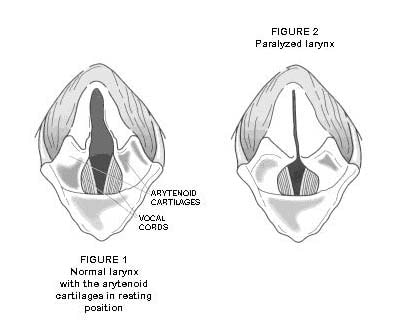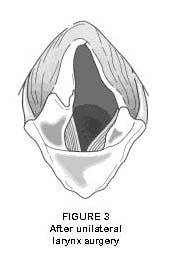A Common Cause of Respiratory Difficulties: Laryngeal Paralysis
Reader "Dogpeople" recently requested a post on laryngeal paralysis after having to deal with it in her own dog — successfully, by the sounds of it. Congratulations!
First, some anatomy and a pronunciation guide. The larynx (lair-ingks not lair-nicks - sorry to nitpick but "lair-nicks" sets my teeth on edge for some reason) is a structure that is located at the top of the throat, just in front of the tubes that lead into the lungs (i.e., trachea) and stomach (i.e., esophagus). When the larynx is fully open, air can pass freely into and out of the lungs. When closed, as is the case when an animal swallows, the larynx prevents food, water, or other substances, including air, from entering the trachea. The larynx also houses the vocal chords and other structures.
How the Larynx Functions in Health
The larynx is a box primarily made out of cartilage and soft tissues. In the middle is an oblong opening that is oriented vertically. To picture this, place your hands together as if you were praying. This approximates the situation when the larynx is closed. Now move your palms apart but leave the tips of your fingers and the heels of your hands together. This is more or less what the laryngeal opening looks like when it is open. Laryngeal muscles contract and relax to open and close the larynx depending on whether an individual needs to breathe or swallow.
What is Laryngeal Paralysis?
When a dog develops laryngeal paralysis, the muscles that control the size of the laryngeal opening do not function normally, meaning that the larynx cannot fully open.
In mild cases, breathing is just slightly restricted, resulting in intermittent episodes of noisy breathing. More severely affected dogs may also tire easily, pant excessively, experience voice changes, have to work harder to breathe, and collapse. Stress and hot weather seem to make the symptoms worse. Some dogs with laryngeal paralysis also develop a condition called megaesophagus, which can lead to regurgitation and weight loss.
Laryngeal paralysis most commonly affects middle aged to older, large breed dogs, especially Labrador retrievers. Veterinarians do not know why some individuals develop laryngeal paralysis and others do not. There may be an association with hypothyroidism or diseases affecting nerves, but in most cases, no underlying condition can be identified.
Diagnosis and Treatment of Laryngeal Paralysis
In many cases, the symptoms of laryngeal paralysis are distinctive enough to allow a veterinarian to make a tentative diagnosis based on a dog’s history and a physical exam. To reach a definitive diagnosis and rule out concurrent illness, he or she may need to take X-rays of the neck and chest, run blood work (including a test for hypothyroidism), and perform a laryngeal exam under light sedation.
The most commonly recommended way to treat dogs with moderate to severe laryngeal paralysis is with a surgical procedure called a laryngeal tie-back.
This permanently opens up one side of the laryngeal opening to ease breathing. Unfortunately, because the larynx cannot close completely when a dog swallows, aspiration pneumonia is a real concern.
For dogs with mild symptoms associated with laryngeal paralysis, or in those situations where surgery is not an appropriate option, medical management may provide some relief. Weight loss, exercise restriction, maintaining a cool environment, stress reduction, and medications to relieve anxiety help some individuals. Unfortunately, when a dog has both hypothyroidism and laryngeal paralysis, thyroid hormone replacement therapy usually does not significantly improve the symptoms associated with laryngeal paralysis. The best way to treat laryngeal paralysis is determined on a case-by-case basis in light of the severity of a dog’s symptoms and overall health.

Dr. Jennifer Coates
Image: Larynx / via Wikispaces


